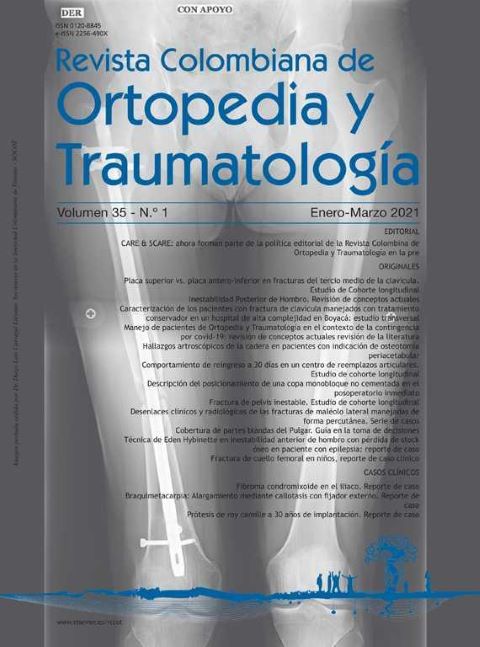30 days re-admission in an articular Joint Arthroplasty center. A cohort Study
DOI:
https://doi.org/10.1016/j.rccot.2021.01.004Keywords:
readmission, arthroplasty, RTC, RTR, 30 days, risk factors, complicationAbstract
Background: Joint replacements are always defined as safe and successful procedures for the treatment of severe osteoarthritis of the hip and knee around the world. Rates of readmission within initial post surgical 30 days and complications are described as a measure to assess quality standards. In Colombia the behavior of the standards are mainly unknown. Aim of study is to provide information from a specialized in joint replacements center in Colombia.Methods: A prospective observational study was carried out on a cohort of 1,126 patients with 626 total hip replacements (THR) and 500 knee replacements (TKR), who underwent surgery between 2011-2015 at a University Hospital in Bogotá, Colombia. 30-day readmission rates and complications were reported. The associations between sociodemographic and clinical variables with readmission and complications were analyzed using a regression model.
Results: 71% of the patients were women, the average age was 63 years for men and 65 years for women. The mean hospital stay was 3.5 days (SD: 0.81-6.29). The 30-day readmission rate for any cause was 10.8% and the rate of complications associated with the procedure was 5.8%. Additional surgical procedures were required in 1.5% of the patients. A statistically significant association was found between the Charlson index greater than 2 (OR = 2.33 [95% CI 1.3-4.18], p = 0.004) and readmission at 30 days. The main complication in THR was dislocation (1.4%) and surgical site infection (4%) in TKR. A significant association was found between complications at 30 days and days of hospitalization (OR = 1.17 [95% CI 1.09-1.25], p = 0.00); and with surgeon 4 in TKR (OR=2.28 [95% CI 1.29-4.01], p=0.04); the other variables did not show significant differences. No differences were found with what is reported in the literature, association with hospital stay and experience of the surgeon.
Discussion: The surgeon’s experience and the application of clinical guidelines that optimize in-hospital processes and regulate the days of hospital stay are related to a better outcome in the evolution of patients in terms of the number of complications and readmissions after 30 days.
Evidence Level: II
Downloads
References
DeVries L, Sturkenboom M, Verhaar J, Kingma JH, Stricker BH. Complications after hip arthroplasty and the association with hospital procedure volumen. Acta Orthopaedica. 2011;82:545-52. https://doi.org/10.3109/17453674.2011.618907
Cullen C. Re-admission rates within 28 days of total hip replacement. Annals of the Royal College of Surgeons of England. 2006;88:475-8. https://doi.org/10.1308/003588406X116909
Husted H, Lunn TH, Troelsen A, Gaarn-Larsen L, Kristensen BB, Kehlet H. Why still in hospital after fast-track hip and knee arthroplasty? Acta Orthopedica. 2011;82:679-84.https://doi.org/10.3109/17453674.2011.636682
Glassou EN, Pedersen AB, Hansen TB. Risk of re-admission, reoperation and mortality within 90 days of total hip and knee arthroplasty in fast-track departments in Denmark from 2005 to 2011. Acta Orthopaedica. 2014;85:493-500, https://doi.org/10.3109/17453674.2014.942586
Belmont P. Morbidity and mortality in the Thirty-day period following Total hip arthroplasty: risk factors and incidence. The Journal of Arthroplasty. 2014 Oct;29:2025-30, https://doi.org/10.1016/j.arth.2014.05.015
Belmont P. Thirty-day postoperative complications and mortality following total knee arthroplasty: incidence and risk factors among a national sample of 15321. Journal of Bone and Joint Surgery. 2014;96:20-6. https://doi.org/10.2106/JBJS.M.00018
Yasunaga H, Tsuchiya K, Matsuyama Y, Ohe K. Analysis of factors affecting operating time, postoperative complications and length of stay for total knee arthroplasty: nationwide webbased survey. Journal of Orthopedic Science. 2009;14:10-6.https://doi.org/10.1007/s00776-008-1294-7
Pugely AJ, Callaghan JJ, Martin CT, Cram P, Gao Y. Incidence of and risk factors for 30-day readmission following elective primary total joint arthroplasty: analysis from the ACS-NSQIP. The Journal of Arthroplasty. 2013;28:1499-504.
https://doi.org/10.1016/j.arth.2013.06.032
Pamilo KJ, Peltola M, Mäkelä K, Häkkinen U, Paloneva J, Remes V. Is hospital volumen associated with length of stay, re-admissions and reoperations for total hip replacement? A population-based register analysis of 78 hospitals and 54505 replacements. Arch Orthop Trauma Surg. 2013;133:1747-55. https://doi.org/10.1007/s00402-013-1860-0
Talmo CT, Aghazadeh M, Bono JV. Perioperative Complications Following Total Joint Replacement. Clin Geriatr Med. 2012;28:471-87, https://doi.org/10.1016/j.cger.2012.05.00
O'Malley NT, Fleming FJ, Gunzler DD, Messing SP, Kates SL. Factors independently associated with complications and lenght of stay after hip arthroplasty: analysis of the National Surgical Quality Improvement Program. Journal of Arthroplasty.2012;27:1832-7. https://doi.org/10.1016/j.arth.2012.04.025
Courvoisier DS, Combescure C, Agoritsas T, Gayet-Ageron A, Perneger TV. Performance of logistic regression modeling: beyond the number of events per variable, the role of data structure. J Clin Epidemiol. 2011;64:993-1000, https://doi.org/10.1016/j.jclinepi.2010.11.012





